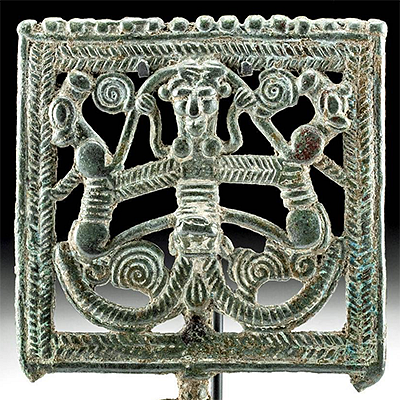Early 20th C. Malagan New Ireland Polychrome Wood
Lot 101
About Seller
Artemis Fine Arts
686 S Taylor Ave, Ste 106
Louisville, CO 80027
United States
Selling antiquities, ancient and ethnographic art online since 1993, Artemis Gallery specializes in Classical Antiquities (Egyptian, Greek, Roman, Near Eastern), Asian, Pre-Columbian, African / Tribal / Oceanographic art. Our extensive inventory includes pottery, stone, metal, wood, glass and textil...Read more
Categories
Estimate:
$1,500 - $2,000
Absentee vs Live bid
Two ways to bid:
- Leave a max absentee bid and the platform will bid on your behalf up to your maximum bid during the live auction.
- Bid live during the auction and your bids will be submitted real-time to the auctioneer.
Bid Increments
| Price | Bid Increment |
|---|---|
| $0 | $25 |
| $300 | $50 |
| $1,000 | $100 |
| $2,000 | $250 |
| $5,000 | $500 |
| $10,000 | $1,000 |
| $20,000 | $2,500 |
| $50,000 | $5,000 |
| $100,000 | $10,000 |
| $200,000 | $20,000 |
About Auction
By Artemis Fine Arts
Nov 5, 2020
Set Reminder
2020-11-05 10:00:00
2020-11-05 10:00:00
America/New_York
Bidsquare
Bidsquare : Ancient & Ethnographic From Around the World
https://www.bidsquare.com/auctions/artemis-gallery/ancient-ethnographic-from-around-the-world-5916
Ancient art from Egypt, Greece, Italy and the Near East, as well as Asian, Pre-Columbian, Native American, African / Tribal / Oceanic, Spanish Colonial, Russian Icons, Fine art, much more! All categories, all price ranges... all legally acquired and guaranteed to be as described or your money back. Artemis Fine Arts info@artemisgallery.com
Ancient art from Egypt, Greece, Italy and the Near East, as well as Asian, Pre-Columbian, Native American, African / Tribal / Oceanic, Spanish Colonial, Russian Icons, Fine art, much more! All categories, all price ranges... all legally acquired and guaranteed to be as described or your money back. Artemis Fine Arts info@artemisgallery.com
- Lot Description
Oceania, Papua New Guinea, New Ireland, Libba village, ca. early 20th century CE. An elaborately painted and carved wood openwork of an anthropomorphic stylized figure standing upon an integral flat circular base. His legs, loincloth, and three ornamental pointed columns support his standing pose and large headdress. The surface is painted with red, yellow, white, and black pigments that highlight his features. Alternating bands and triangles of color travel from the legs up to an intricate circular pendant with a mandala-like pattern painted directly onto his chest. The angular head has lustrous green and brown shell eyes set within white painted diamonds that give a lifelike quality to the otherwise abstract figure. The impressive headdress is formed by a central solid cylinder surrounded by four taller curved points. A magnificent ritual figure perhaps created for the malagan funerary rituals to house the soul of the deceased! Size: 4.75" W x 19.25" H (12.1 cm x 48.9 cm)
New Ireland is a province of Papua New Guinea, and the art of this area centers heavily on the ritualistic and funerary aspects of their culture. Elaborate ceremonies and feasts held to honor the dead are known as "malagan" and this word is also used to describe the carved figures created for these ceremonies. The ritual feasting, carving, and performances to usher the soul of the deceased into the afterlife can last up to several years, depending on the wealth of the family sponsoring the festivities. Sometimes when deaths occurred close together, multiple families pooled resources to defray the cost of these ceremonies to simultaneously honor more than one deceased person. The sculpture's purpose was to honor the individual in an idealzed way. It was not a portrait of the physical characteristics, rather it was created to demonstrate their ancestral ties, rank, and/or power through details, such as the painted headdress and pendant of this piece! Malagan provided a physical place or house for the soul to live in during the funerary ceremonies, and were handled with care, as if a living being. Once the ceremonies were concluded, the soul was thought to have left the malagan and these sculptures were discarded; either burned or left to decay, they were not reused for any future souls because of their individulized nature.
Provenance:private New York, New York, USA collection; ex-Dr. Abe Rosman: Anthropology Professor Emeritus Barnard College, Columbia University, New York, New York, USA
All items legal to buy/sell under U.S. Statute covering cultural patrimony Code 2600, CHAPTER 14, and are guaranteed to be as described or your money back.
A Certificate of Authenticity will accompany all winning bids.
We ship worldwide and handle all shipping in-house for your convenience.
#159268Several headdress points reattached. Stable fissures and cracks on backside and base. fading and chipping of pigment. Vibrantly painted and detailed with shell eyes!Condition
- Shipping Info
-
All shipping is handled in-house for your convenience. Your invoice from Artemis Gallery will include shipping calculation instructions. If in doubt, please inquire BEFORE bidding for estimated shipping costs for individual items.
-
- Buyer's Premium



 EUR
EUR CAD
CAD AUD
AUD GBP
GBP MXN
MXN HKD
HKD CNY
CNY MYR
MYR SEK
SEK SGD
SGD CHF
CHF THB
THB
















